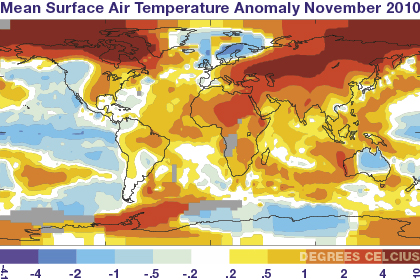La Niña good for neither regatta nor harbour
Much of the mud results from just a few storms.

Cool La Niña: The cooling effect of the strong La Niña means that 2010, rather than being the hottest year on instrumental record, will likely tie with 2005 for that alarming title—despite the recent solar irradiance minimum. map National Aeronautics and Space Administration, Goddard Institute for Space Studies (base period 1951–1980, smoothing radius 1200 km, grey denotes absence of data)
The quantity of sediment reaching the Mahurangi Harbour annually can range from 13 000 to 136 000 tonnes, reflecting the major rainfall events such as that which accompanied Cyclone Bola.
And heavy rainfall events are increasing, as global warming puts more moisture in the atmosphere—400 grams per cubic metre, per decade, since 1988. That moisture, in the short term, also means more snow.
The harbour’s best defence is for the catchment to be reforested. While the harvesting of radiata pine attracts considerable opprobrium, the averaged sediment generation is generally less than for pastureland. The ideal production forestry probably involves higher value, slower growing timber trees, under a continuous canopy regime. And so much the better if the species grown are indigenous, providing better habitat for indigenous fauna. Indigenous forestry has many hurdles to overcome but the Mahurangi is conducting the first-ever trials comparing indigenous plants raised by open-ground methods, compared with potted and root trainer stock. This open-ground, forestry-style approach could see plants produced at closer to the radiata price—30 cents each, or less. Short of reforestation, careful pasture management has been found to greatly reduce sediment generation.
While of social rather than environmental impact, a wet summer could see the cancellation of the Mahurangi Regatta shoreside events. Since being revived by Friends of the Mahurangi in 1974, the traditional picnic and beach events have only twice been cancelled outright due to wind and/or rain.
In 1989, the Mahurangi Regatta shoreside events were postponed to allow the ground at Sullivan Bay to dry sufficiently for cars to be parked. A record wet summer had so waterlogged the grassed areas that any car attempting to park would have required towing. Things then turned ugly when one yachtsman organised a telephone campaign aimed at coercing the then resident park ranger to reverse the jointly agreed decision. Postponement of the shoreside events proved to be only partially successful—a damp squib without the backdrop of yacht racing, which had proceeded on the traditional day oblivious of the shambles ashore.
Mercifully, since its revival in 2004, the prize-giving and dance at Scotts Landing has not been rained or blown out. However, the heavy rain that fell briefly in the early evening of last summer’s regatta was a rude reminder of the weather-dependency of the dance; sailors were almost an hour slower in coming ashore. Had the rain set in, few would have budged from the parties that were rapidly developing below decks, particularly as finances had precluded the hiring of the usual generously-sized marquee. This summer, an old-style roomy 18 x 18-metre marquee is being provided by Warkworth’s McEntee Hire.

Regatta Venison Burger: Fine fast food is key to catering where an anticipated crowd of a thousand could be slashed by rain to a hardcore hundred. image Stubbs Village Butchery
Organisers of the shoreside events have long been mindful of the need to limit the financial exposure of the event. The key is keeping the event low-key and have the flexibility of cancelling band, marquee and catering at the last minute. It also the reason that food requiring slow cooking has been avoided, in favour of venison burgers. And thanks to Stubbs Village Butchery, the exposure involved in committing to a thousand patties has been eliminated—Regatta Venison Patties are now a very popular line, and the butchery has undertaken to have 1000 available in their chiller, should they be needed.
In February 2004, vagaries of the weather and insurance company rules conspired to permanently put paid to the previously brilliantly successful Warkworth Rotary Print and Packaging Regatta. By the time the depression had crossed the North Island from the Tasman, marquees were in the treetops and the barge load of high-class Sky City cuisine delivered to Kawau Island was languishing for the want of the thousand paid up participants.
Scotts Landing has a venerable heritage for hospitality, as reported by the Daily Southern Cross, 7 January 1863:
Mr Scott, the proprietor of the Mahurangi Hotel, deserves much credit for the very efficient manner everything was conducted in his establishment, where the greatest order and harmony prevailed, and where visitors received every attention.
And since the Scott property became a regional park, it is a given that all visitors be made welcome. This precludes fencing out the hoi polloi. The 2004 Mahurangi Regatta Ball, as sublime as it was, failed to cater for those arriving unaware festivities were a ticket-only affair.
With this summer forecast to be the wettest in 21 years, the prize-giving dance faces a higher-than-usual risk of cancellation. Ideally, short of a cyclone, or the tail end of one, the marquee would go up and the show would go on. But the scenario that could leave organisers exposed to the loss of $6000 or more, is where a week of wet weather weakens the resolve of all but the fanatical few, and a soggy evening sees dozens of volunteers turned out, but no way of recouping the cost of barbecues, perishables, lighting, sound system, band, marquee, toilets and the usual mess of essential minutiae such as mobile electronic transaction facilities.
And as yet, aside from Stubbs Village Butchery, no underwriter has stepped up.
Although this summer’s event is precarious, prospects for the 2012 Mahurangi Regatta and beyond have just improved. These days, Rodney District Council’s most dynamic mayor ever, John Law, is a director of the Tourism, Events and Economic Development council-controlled organisation. That Scotts now has a landing worthy of its name is in good part thanks to Mr Law, as is the Scotts Landing boardwalk, expedited in time for the regatta ball.
The Mahurangi Regatta readily ticks the tourism and event boxes, but it also potentially ticks economic development—Mayor Law vigorously promoted ‘connectivity by the sea’. By supporting the further development of landings, on both sides of the harbour, ferry and excursion services can be fostered. A localised need is for users of the Mahurangi Regional Park to be able to ferry between Scotts Landing and Sullivan Bay, for example, or between Sullivan and Lagoon bays—the latter having no road access.
Auckland Council is acutely aware of the need to demonstrate it understands the needs of its rural hinterland. Happily, urban and rural shoulders have long rubbed together at the Mahurangi Regatta. The inaugural 29 March 1901 edition of the Rodney Times reported:
Favoured by beautiful weather and a steady breeze came up from the south at midday. The Mahurangi Regatta Committee and its energetic secretary (Mr W J Wilson) are to be highly congratulated upon the satisfactory results.
The ‘Heads’ is one of the most suitable places within so short a distance from Auckland for regatta purposes. It being within reach of the Auckland Yachtmen, who are certain to take advantage of the outing, and should the committee decide to make it an annual event, as indeed they have every encouragement to do.
Moreover since 1979, Mahurangi has shared Auckland Anniversary weekend with the Auckland Anniversary Regatta, providing a comely curtain raiser to the world-famous event. But for the event to be sustainable, its organisation must become more collaborative. The active involvement of the participating yacht clubs is essential on a number of levels. If ‘Auckland Yachtmen’ find one or two of their fellows on the other side of the bar, the penny would drop that this ‘their’ event and the paid help are in fact a bevy of volunteers toiling to uphold a noble Mahurangi tradition. Certainly it is unfair and unrealistic to recruit the help year after year primarily from the miniscule local population.
The benefits of a healthy, respectful urban–rural relationship extend well beyond the Mahurangi Regatta. The task of addressing the elevated sediment accumulation rate, begun by the regional council the year of the regatta ball, is a decades-long one. The resources required are well beyond the catchment’s ratepayers. The regatta is the singular opportunity to inform the regional audience of the Mahurangi’s predicament and enlist support for the long-term battle to minimise sediment generation.
If La Niña does her worst, washing out regatta shoreside events, at least appetites will be whetted for 2012 when greater collaboration should see less time queuing, more time dancing.
